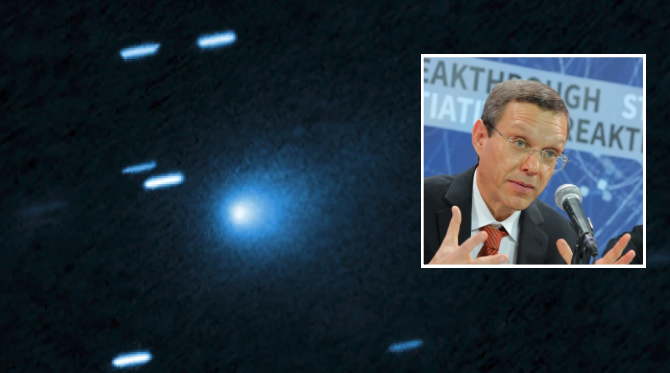Key Point Summary – Possible Alien Object
- Hubble captures clearest image yet of interstellar object 3I-ATLAS
- Object traveling 130,000 mph, will pass near Mars but miss Earth
- Harvard astronomer Avi Loeb suggests unusual glow could mean artificial origin
- One of only three confirmed interstellar objects seen in our solar system
- Loeb warns we must prepare for possibility of alien technology
When the Hubble Space Telescope turned its gaze to a distant visitor, it caught something extraordinary. The object, named 3I/ATLAS, is hurtling toward the inner solar system at a blistering 130,000 mph. It’s not from here — astronomers confirmed it originated beyond our Sun’s reach.
Originally thought to be several miles wide, new Hubble data shows its core is smaller, perhaps just 3.5 miles across — or even as tiny as 1,000 feet. Yet despite its size, it carries an air of mystery that has set the scientific world buzzing.
Harvard Scientist Suggests Unnatural Origin for Possible Alien Object
Avi Loeb, Harvard’s outspoken astronomy chief, isn’t ready to dismiss 3I/ATLAS as just another icy wanderer. Speaking to CNN, he noted its strange glow — which appears in front of the object, not behind it like a typical space traveler’s tail. “We’ve never seen such a thing,” he said.
He went further, hinting that an artificial origin couldn’t be ruled out. “I’m not saying it’s alien technology,” Loeb insisted, “but it doesn’t look like a very common thing.”
Perfect Time to Hide?
Loeb pointed out that when 3I/ATLAS gets closest to Earth, our planet will be on the opposite side of the Sun. We won’t be able to see it. For him, that timing is suspicious. “That’s the perfect time for it to maneuver,” he warned. “We just need to watch it.”
The object will pass closer to Mars than Earth, staying at a safe distance from both. It was 277 million miles away when Hubble snapped its latest image in July, showing a teardrop-shaped dust cloud and faint trail.
History of Strange Interstellar Guests
3I/ATLAS joins an elite list — it’s only the third confirmed interstellar object ever seen passing through our solar system. The first, ‘Oumuamua, appeared in 2017 and baffled scientists with its cigar shape and unusual motion. Loeb famously suggested it might be propelled by a “light sail,” perhaps built by extraterrestrials.
In 2023, Loeb also claimed a recovered Pacific Ocean meteor might contain alloys never before seen, hinting again at alien manufacture. Critics dismissed the claims, but Loeb’s persistence keeps the debate alive.
Public Divided Over Alien Theory
Reaction online has been split. Space enthusiasts are thrilled by the possibility of alien contact, flooding social media with theories ranging from interstellar probes to ancient space beacons. Others dismiss the excitement as hype, calling the object a “dirty snowball” with quirks easily explained by science.
Some fear sensational talk could overshadow the real value of studying interstellar objects — rare opportunities to learn about the composition of distant star systems.
Scientists Urge Vigilance
Even skeptics agree on one thing: every visitor from another star deserves close attention. Loeb argues that we should monitor all such objects for signs of artificial design, warning, “It may come to save us or destroy us. We’d better be ready for both options.”
Researchers will track 3I/ATLAS as long as possible before it disappears back into the darkness. If it’s just a natural fragment, it will join the cosmic catalog of harmless wanderers. If it’s something else… we might never know for sure.
What Comes Next for 3I/ATLAS?
The object’s trajectory will eventually carry it out of the solar system, leaving scientists with only a brief window to study it. Current plans involve using multiple telescopes to gather as much data as possible before it’s gone for good.
Whether it’s a natural fragment of another star system or a product of alien engineering, 3I-ATLAS has already achieved something rare — it’s reignited public fascination with the possibility that we’re not alone.




